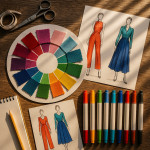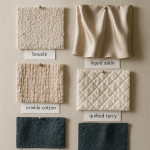Draping basics: videos and books that refine your fashion silhouettes
Ready to elevate your garment ideas from flat sketches to sculptural showpieces? This guide gathers the most effective draping videos, essential books and a 30-day practice plan so you can master fabric manipulation, perfect proportions and fluid silhouettes—without enrolling in costly courses.
Why draping remains essential in the 3D-software era

Watching someone drape fabric in silence can look deceptively simple, yet the micro-adjustments made every few seconds integrate years of tactile experience: how the grain shifts over the clavicle curve, when to lift cloth to relieve tension, or how a single pin locks bias pull without restricting movement. By placing your own hands on the form immediately after observing a demonstration, you teach fingers to memorise these invisible calibrations. Seasoned professionals even narrate each action aloud—“anchor at centre front, ease at bust, true the balance line”—because verbal cues lodge the sequence in both visual and muscle memory. When repeated across consecutive sessions, this self-commentary accelerates skill adoption far more effectively than passive watching alone, turning fleeting video impressions into dependable studio reflexes that inform every future silhouette you cut.
Digital pattern software is powerful, yet nothing replaces the tactile feedback of fabric pinned directly on a dress form. Draping basics help you:
- Validate volume, grainline and balance before cutting final fabric.
- Iterate faster than on screen when experimenting with bias or complex gathers.
- Communicate ideas clearly to sample makers and factories.
- Develop a designer's “eye” for proportion, the same skill that informs colour selection and contrast.
Core draping vocabulary in one minute
Before diving into resources, lock in these terms:
- Grainline: direction of threads; on-grain panels hang smoothly.
- Trueing: transferring pinned fabric lines to paper, smoothing curves.
- Balance line: horizontal reference to keep left and right sides equal.
- Muslin: inexpensive cotton used for test drapes.
- Slash & spread: cutting into the fabric to add volume, often seen in circle skirts.
The five YouTube channels that make complex folds click
Videos give real-time insight into finger positions, pin angles and fabric tension—details static images can't convey. Add these channels to your watch list:
- Colleen G Lea – clear, step-by-step bodice and sleeve drapes for beginners.
- University of Fashion – short, curriculum-style lessons filmed from multiple angles.
- Fashion Sewing Blog TV – bias drape demos using everyday fabrics, ideal for home studios.
- Nick Verreos – quick tips on red-carpet silhouettes and manipulating chiffon.
- Made to Sew – in-depth series on translating draped muslins into precise paper patterns.
Build a results-driven playlist
Watching randomly will overwhelm you. Follow this sequence:
- Week 1: Basic bodice block drape.
- Week 2: Dart manipulation and princess seams.
- Week 3: Bias cowl and fluid skirts.
- Week 4: Advanced elements—collars, sleeves, asymmetric styles.
Pair each video day with a 45-minute hands-on session. Log adjustments in a notebook; the habit mirrors the reflection process used in pattern-making roadmaps.
Books that turn draping fundamentals into creative muscle memory
| Title & Author | Ideal Skill Level | Key Takeaway | Why It Complements Video Learning |
|---|---|---|---|
| Draping: The Complete Course by Karolyn Kiisel | Beginner → Intermediate | Step-by-step photos of 30 projects, from basic blocks to bias evening gowns. | QR codes link to mini-videos; reinforces visual cues with detailed text. |
| Draping for Apparel Design by Helen Joseph-Armstrong | Intermediate | In-depth pattern conversion techniques and industry standards. | Use as a reference when transcribing muslin markings onto paper. |
| The Art of Fashion Draping by Connie Amaden-Crawford | Intermediate → Advanced | 150+ design variations, including menswear and knitwear adaptations. | Challenges you to push beyond basic shapes, echoing modern runway needs. |
| Patternmaking for Fashion Design by Helen Joseph-Armstrong | All levels | Although focused on flat patterns, it clarifies how drape lines convert to blocks. | Bridges draping and flat pattern skills—vital for production hand-off. |
30-day mannequin sprint: your draping basics practice plan
Commit to daily micro-sessions to cement muscle memory.
- Days 1-5: Mark mannequin balance lines and practice pin anchoring; repeat until pins sit flush.
- Days 6-10: Drape and true a bodice block twice—once in muslin, once in lining fabric.
- Days 11-15: Explore dart rotation; create one style line per day.
- Days 16-20: Bias experiments—cowl neck, waterfall ruffle, bias tube skirt.
- Days 21-25: Combine structures: bodice + gathered skirt; bodice + mermaid flare.
- Days 26-30: Final project. Re-create a reference runway look, photograph and assess proportion.
Track time, fabric used and corrections. This data-driven reflex will serve you well when forecasting material consumption, similar to the habits in trend-forecasting workflows.
Common draping mistakes and quick fixes
- Excess pinning: If fabric puckers, remove pins, smooth from grainline outwards and repin sparingly.
- Ignoring mannequin posture: Always level the dress form; tilted stands distort hip balance.
- Skipping staystitching: For bias areas, a quick staystitch prevents stretching during trueing.
- Poor scissor choice: Blunt scissors shred muslin edges—upgrade as you would your sewing machine tools.
Interactive quiz: test your draping savvy
FAQ
- Do I need an industry-grade mannequin to start?
- No. A mid-priced adjustable dress form works. Prioritise correct measurements over brand names.
- How much muslin should I buy for practice?
- Ten metres covers the 30-day sprint. Buy unbleached muslin; wrinkles iron out easily.
- What thread colour is best for marking?
- Use contrasting, non-stretch thread—often red—for clear visibility when transferring lines.
- Can I combine draping with digital pattern software?
- Absolutely. After trueing your muslin, digitise the paper pattern and refine in CLO 3D or Optitex.
- Where can I find structured online training beyond YouTube?
- Explore the curated fashion-design training catalogue on Artfolio for instructor-led courses.
Next steps: turn your drapes into production-ready patterns
You now have a toolkit—videos for live cues, books for depth, plus a practice routine. Translate your draped muslins into graded patterns, test in your chosen fabrics and refine finishing techniques. Your future collections will showcase silhouettes that move as beautifully as they look.
Ready to start? Block 30 minutes today, pin that first bodice and experience how fabric, gravity and imagination converge on the form.











